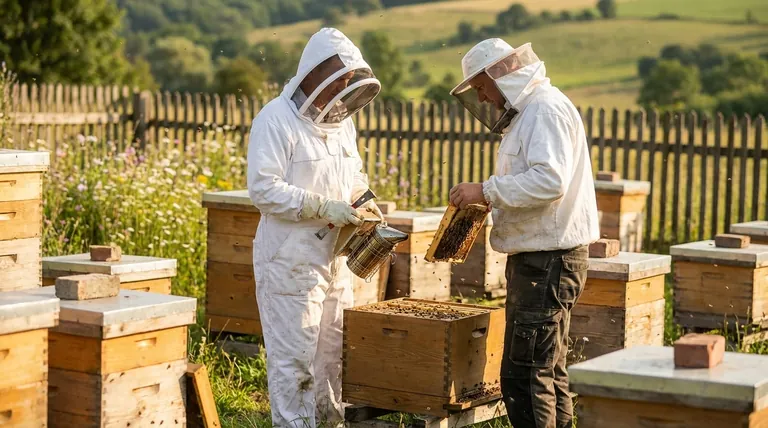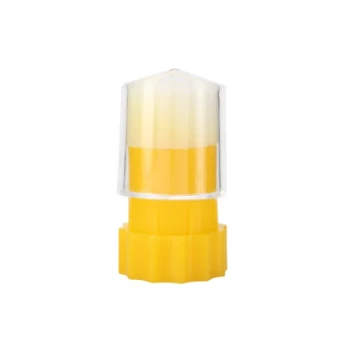The single most important factor in choosing between a bee jacket and a full bee suit is the level of protection you need to feel confident and safe while working with your bees. A full suit offers complete, head-to-toe security, which is often preferred by beginners. A jacket provides substantial upper-body protection while offering greater convenience and comfort, a trade-off many experienced beekeepers are willing to make.
The decision is not about which option is objectively "better," but which is right for your specific temperament, climate, and beekeeping style. It's a direct trade-off between the absolute security of a full suit and the comfort and convenience of a jacket.

Breaking Down Your Protective Gear Options
To make an informed choice, it's essential to understand the distinct purpose and design of each garment. They solve the same core problem—preventing stings—but in fundamentally different ways.
The Full Bee Suit: Maximum Security
A full beekeeping suit is a one-piece garment that covers you from your ankles to your wrists and includes an integrated or detachable hood and veil.
Its primary advantage is unbroken protection. There are no gaps between a top and bottom for a determined bee to exploit. This comprehensive coverage is a significant source of confidence for new beekeepers.
The Bee Jacket: Convenient Protection
A bee jacket is essentially the top half of a full suit, providing protection for your torso, arms, and head with an attached veil.
Beekeepers wear a jacket over their regular clothes, typically pairing it with thick, durable pants like heavy-duty jeans. Its main benefits are that it is easier to put on and take off and is significantly cooler in hot weather.
Key Factors to Guide Your Decision
Your personal comfort level is the starting point, but other practical considerations will determine which option serves you best in the long run.
Your Personal Confidence Level
Beekeeping requires calm, deliberate movements. If you are anxious about being stung, you are more likely to make sudden, clumsy motions that can agitate a colony.
For those who are highly concerned about stings, a full suit is the superior choice. The peace of mind it provides allows you to focus on learning and interacting with your bees calmly.
The Temperament of Your Bees
Not all honeybee colonies are the same. Some are remarkably docile, while others can be defensive and "hot," especially during certain times of the year.
If you are working with a particularly aggressive hive or are performing a more intrusive task like a honey harvest, the guaranteed protection of a full suit is invaluable.
Climate and Physical Comfort
Beekeeping often involves physical work on hot, sunny days. A full bee suit can become extremely hot and stifling, leading to discomfort and even the risk of overheating.
A jacket is significantly more lightweight and breathable, making it a more practical choice for quick inspections or for beekeepers living in warmer climates.
Understanding the Trade-offs
Neither option is perfect. Being aware of the inherent compromises of each choice is critical for avoiding common mistakes and potential stings.
The Suit's Downside: Heat and Hassle
The main drawback of a full suit is its bulk. It's hotter, heavier, and more cumbersome to put on, take off, and store. For a five-minute hive check, the effort can sometimes feel excessive.
The Jacket's Vulnerability: The Waist Gap
The convenience of a jacket comes with one major vulnerability: the gap at your waist. An improperly secured jacket or pants that are too thin can create an entry point for bees.
This is the most common failure point. You must ensure your jacket and pants overlap generously and that your pants are made of a thick, sting-resistant material. Standard leggings or thin trousers are not sufficient.
Making the Right Choice for Your Goal
Your decision should align directly with your priorities as a beekeeper.
- If your primary focus is maximum peace of mind as a new beekeeper: Start with a full bee suit to build confidence without the fear of stings.
- If your primary focus is comfort in a hot climate or convenience for quick inspections: A bee jacket paired with thick, durable pants offers the most practical balance of protection and ease of use.
- If your primary focus is absolute safety when dealing with aggressive or unfamiliar hives: The gap-free protection of a full bee suit is the only responsible choice.
Ultimately, the best protective gear is the gear you will wear consistently, allowing you to work with your bees calmly and effectively.
Summary Table:
| Feature | Full Bee Suit | Bee Jacket |
|---|---|---|
| Protection Level | Maximum (head-to-toe) | Substantial (upper body) |
| Best For | Beginners, aggressive hives, hot climates | Experienced beekeepers, quick inspections, hot climates |
| Key Advantage | Unbroken protection, peace of mind | Lightweight, breathable, convenient |
| Main Drawback | Can be hot and cumbersome | Vulnerable gap at the waist |
Ready to Gear Up with Confidence?
Whether you're a new beekeeper needing the security of a full suit or a commercial apiary prioritizing the comfort of jackets for your team, the right equipment is essential for safe and productive hive management.
HONESTBEE supplies durable, high-quality beekeeping suits, jackets, and protective gear designed for the demands of commercial beekeepers and distributors. We help you protect your most valuable asset—your people—so they can work calmly and effectively.
Contact HONESTBEE today to discuss your wholesale needs and find the perfect protective solution for your operation.
Visual Guide

Related Products
- Beekeeping Jacket with Hood and Veil for Beekeepers
- Economy Polyester Beekeeping Jacket with Veil and Hat
- Cotton Beekeeping Suit and Round Hat with Veil Bee Keeper Protective Gear
- White Beekeeping Protective Suit and Hat with Fencing Veil for Beekeepers
- Heavy Duty Cowboy Beekeeper Hat with Visibility Veil Outdoor Professional Beekeeping Protective Gear
People Also Ask
- What are the key features of a good beekeeping jacket? Unlock Confidence and Comfort at the Hive
- What are the cons of wearing a bee jacket? Understanding the Protection Trade-Offs
- What should I wear under a bee suit? Essential Clothing for Maximum Protection & Comfort
- What are the advantages of using a beekeeping jacket instead of a full suit? Unlock Speed and Comfort
- What are the advantages of a beekeeping jacket? Superior Mobility & Comfort for Routine Hive Inspections



















